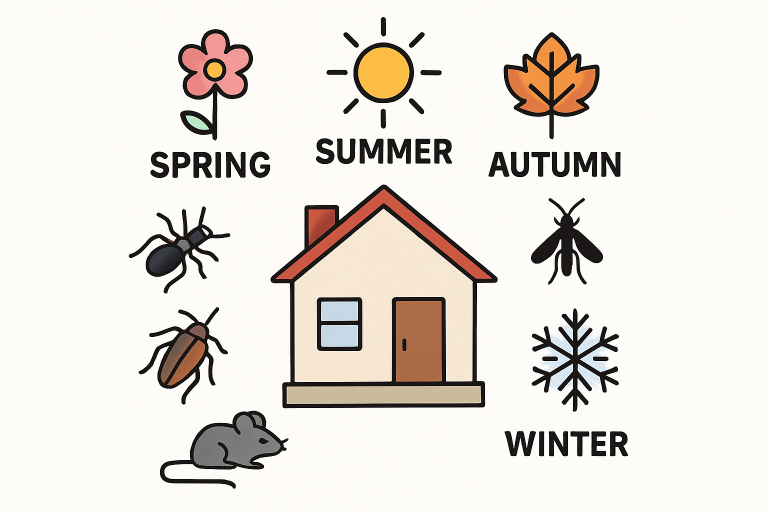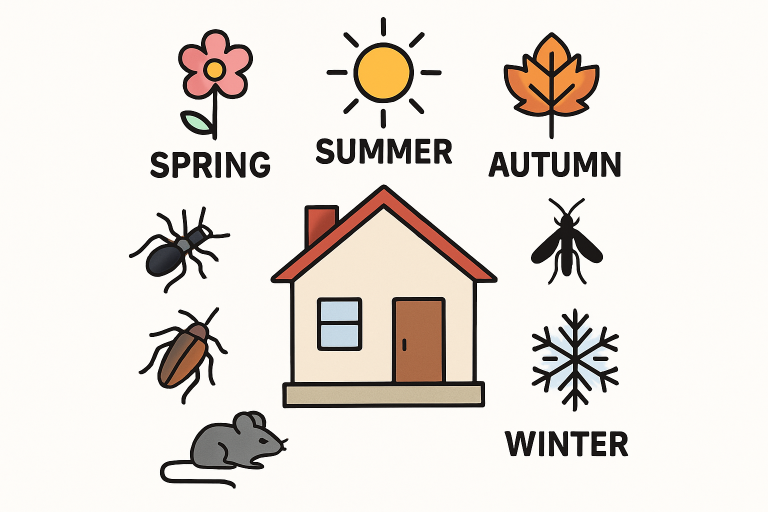House and Home
Seasonal Strategies for Pest Control Success
Key Takeaways
- Each season presents unique pest challenges; proactive, targeted action is essential for adequate control.
- Integrated Pest Management (IPM) combines prevention, monitoring, and targeted treatment for sustainable results.
- Embracing technology and community engagement further bolsters pest control efforts.
Introduction
Effectively managing pests requires a dynamic approach that changes with the seasons. When pests emerge in cycles, adapting your pest management plan from spring’s awakening through winter’s indoor challenges is essential. This is where year round pest control planning becomes critical for homeowners and businesses seeking to prevent infestations and maintain healthier living environments all year.
Through tailored, seasonal strategies and proactive measures, pest problems can be anticipated and addressed before they become costly. Leveraging these methods ensures the comfort and health of families and staff and protects property investments from pest-related damage.
Spring: Awakening Pests
Warmer temperatures and increased rainfall in spring signal the return of pests that have lain dormant through the colder months. Ants, termites, and other pests take advantage of moist conditions, often invading homes searching for food and nesting sites.
- Repair plumbing leaks, ensure that downspouts and drain channels water away from your home’s foundation.
- Inspect baseboards, crawlspaces, and exterior walls for early indicators of termites—such as mud tubes—or visible ant trails.
- Opt for natural deterrents like diatomaceous earth, vinegar, or essential oils that protect your environment without harsh chemicals.
Winter: Indoor Pest Challenges
The coldest months force rodents, cockroaches, and other resilient pests to search for warmth, water, and food inside homes and businesses. Vigilant efforts can stop infestations before they take hold.
- Inspect attics, basements, and crawl spaces for holes or cracks, sealing them with durable materials.
- Store food in airtight containers, and quickly clean up crumbs to cut off vital pest food supplies.
- Position rodent traps and strategic baits in hidden areas frequented by rodents or cockroaches.
A successful defense against pests is never a one-off task—it demands persistent planning and action. By a year round pest control planning, you strengthen your strategy and reduce the risk of surprise infestations when the seasons change.

Summer: Peak Pest Activity
Summer’s heat accelerates pest breeding cycles, bringing an uptick in mosquitoes, flies, and stinging insects. Outdoor gatherings, gardens, and even unattended trash bins can become attractive to pests this season, making consistent monitoring and control necessary.
- Dump and scrub containers that collect water, from plant saucers to pet bowls and birdbaths, to break the pest breeding cycle, especially for mosquitoes.
- Light citronella candles or apply essential oil sprays at entryways and seating areas to help keep mosquitoes and flies at bay.
- Deploy biological pest controls, such as introducing mosquito larvicides to ponds, to curb populations without harming beneficial insects or wildlife.
Autumn: Preparing for Overwintering Pests
As days grow cooler, many outdoor pests seek warmth indoors. Boxelder bugs, stink bugs, and rodents tend to invade homes in fall, necessitating preventive measures before they settle in for winter.
- Clear leaves and plant debris from gardens and around the home’s foundation, which can provide shelter for pests.
- Seal gaps in siding, around windows, utility pipes, and under doors with weatherproof caulking or steel wool to ensure pests cannot enter to overwinter inside.
Integrated Pest Management (IPM): A Year-Round Approach
Integrated Pest Management (IPM) is the gold standard for modern pest control. This approach merges routine inspections, preventive actions, education, and precise treatment to minimize pest impact and reliance on chemicals. Key IPM practices include:
- Scheduling regular professional or DIY inspections to spot early warning signs saves money and headaches.
- Building awareness among household members or employees about sanitation habits and maintenance routines that discourage pest activity.
- Targeting chemical interventions only in problem areas, reducing broad exposure to active ingredients.
Leveraging Technology in Pest Control
Technology is reshaping pest control. These innovations, from digital monitoring tools to biological tracking, are making detection and intervention more precise. A noteworthy advancement is the employment of trained dogs to locate invasive species like spotted lanternfly eggs, a method that has succeeded in early detection and suppression campaigns.
Community Engagement and Education
Efforts are exponentially more effective when communities work together. Educating neighborhoods on pest identification, reporting, and preventive measures can halt infestations before they start or spread.
- Organize demonstration workshops to help neighbors learn and apply best practices in pest prevention.
- Distribute quick-reference materials detailing common pests and their signs, empowering residents to take swift, informed action.
- Promote a ‘see something, say something’ culture by encouraging people to notify local authorities about unusual or escalated pest activity.
By embedding these seasonal strategies into daily routines, property owners and communities foster healthier and less inviting environments for pests, year after year.

